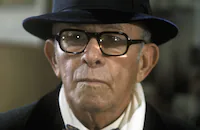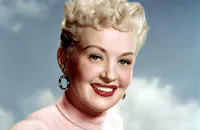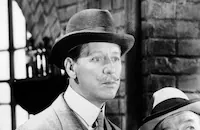College Swing

Brief Synopsis
Cast & Crew
Raoul Walsh
George Burns
Gracie Allen
Martha Raye
Bob Hope
Edward Everett Horton
Film Details
Technical Specs

Synopsis
In 1738 in Aldentown, Gracie Alden fails to graduate from college for the ninth consecutive year and her grandfather, founder of the college, wills it to the first female Alden progeny to graduate. Two hundred years later, Gracie's namesake is again about to lose her inheritance, which will be forever forfeited to the city. Bud Brady offers to tutor her for $10,000, to be paid by the Guarantee Trust Company, which controls the university's mortgage. Guarantee Trust is owned by Hubert Dash, an Alden descendant who has a chronic fear of women and who will prepare Gracie's final exam. Hubert's secretary, George Jones, shares Hubert's fear of women. Meanwhile, Dash's nephew, Martin Bates, must serenade Ginna Ashburn, daughter of the university president, for a fraternity initiation and is caught shirtless by the prudish Dean Sleet. On the day of the final, George conducts the exam in Hubert's absence. Gracie, equipped by Bud with a cheat-sheet, passes by guessing answers off his laundry bill. Finally the owner of the university, Gracie appoints herself "Dean of Men," abolishes all entrance exams, and hires a new faculty of incompetent "kooks." Hoping to avoid the school's sinking reputation, Martin's guardians at Guarantee Trust ask him to transfer to Oxford, while Ginna's father resigns. Having sworn his love to Ginna, Martin promises to talk to his uncle, but Hubert, using a misogynistic syllogism, deduces that all women are schemers and threatens to retract Gracie's university land grant pending a new examination. Meanwhile, Bud gets the new faculty femme fatale to sneak into Hubert's room and scare him out of town. Gracie, overhearing their scheme, goes to warn Hubert and they fall in love. The next day when Gracie's exam is broadcast on national radio, Bud feeds her the answers through headphones and is discovered. Gracie then resolves to be herself and returns the university to Ashburn, to the relief of Ginna and Martin, and confesses her marriage to Hubert the previous night.

Director

Raoul Walsh
Cast

George Burns

Gracie Allen

Martha Raye

Bob Hope

Edward Everett Horton
Florence George

Ben Blue

Betty Grable

Jackie Coogan

John Payne

Cecil Cunningham

Robert Cummings
Skinnay Ennis
The Slate Brothers
Bob Mitchell And St. Brendan`s Choristers
Jerry Colonna
Charles Trowbridge
Jerry Bergen
The Playboys

Tully Marshall
Edward J. Lesaint
Barlowe Borland
June Ray

Irving Bacon
Crew
Roland Asher
Frederick Hazlitt Brennan
Hoagy Carmichael
Walter Deleon
Hans Dreier
Ernst Fegté
Arthur Franklin
A. E. Freudeman
Lewis E. Gensler
Edith Head
Burton Lane
Ted Lesser
Harold Lewis
Frank Loesser
Francis Martin
Victor Milner
Boris Morros
Manning Sherwin
Leroy Stone
Preston Sturges
Howard Wilson
Adolph Zukor

Videos
Movie Clip




Hosted Intro
Film Details
Technical Specs

Articles
College Swing -
The script, credited to four writers, centers on a young woman (Gracie Allen) who inherits a college, hires vaudevillians as teachers and transforms the campus into a hopping dance joint. This provides the excuse for a number of songs, three of which were written by Frank Loesser and Burton Lane, three by Loesser and Manning Sherwin, and one, the title tune, by Loesser and Hoagy Carmichael. The biggest hit of the score was "Howdja Like to Love Me?", composed by Loesser and Lane and performed by Martha Raye and Bob Hope.
Hope's role was originally conceived for Jack Oakie, but Hope parlayed his friendship with producer Lewis E. Gensler into the part instead. A few years earlier, Gensler had produced a Broadway show, Ballyhoo of 1932 that featured Hope; it flopped, losing money for both men, and Hope now asked Gensler to make it up to him by bulking up his part in College Swing. Gensler agreed, but except for the song with Raye, Hope essentially became simply one of the ensemble of present and future stars, including George Burns, John Payne, Edward Everett Horton and Betty Grable, who was still two years away from breaking into superstardom with Down Argentine Way (1940). "I spent most of the time staring at Betty Grable's legs," Hope later quipped.
By Jeremy Arnold

College Swing -
College Swing
College Swing
Quotes
Trivia
Notes
Jackie Coogan and Betty Grable were married when this film was made.

Miscellaneous Notes
Released in United States 1938
Released in United States on Video May 19, 1993
Released in United States 1938
Released in United States on Video May 19, 1993














